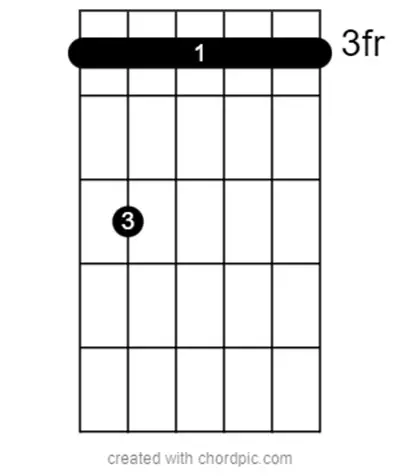What is Gm7 guitar chord? If this is a question you’ve been asking yourself, you’re in the right place. This chord, known for its rich and harmonious sound, is a staple in many songs and genres. In this guide, we will explore the fundamentals of the Gm7 guitar chord, ensuring that you can play it confidently and beautifully.

Understanding the Gm7 Guitar Chord
The Gm7 guitar chord, revered for its captivating and sonorous qualities, stands as a cornerstone in the world of guitar music. It’s more than just a chord; it’s a symphony of notes that come together to create a sound filled with emotional depth and melodic richness.
This chord is a composition of four distinct notes: G, B♭, D, and F. Each of these notes plays a crucial role in giving the Gm7 its unique character.
G – The Root Note:
G, the root note, forms the foundation of the chord. It sets the fundamental tone and establishes the chord’s base, anchoring the harmonic structure.
B♭ – The Minor Third:
The B♭ note introduces a minor quality to the chord. As the minor third, it contrasts with the root, creating a sound that is rich and slightly melancholic. This note is pivotal in defining the ‘minor’ characteristic of the Gm7 chord.
D – The Perfect Fifth:
D, known as the perfect fifth, adds stability and fullness to the chord. It complements the root and minor third, rounding out the chord’s structure and enhancing its harmonic depth.
F – The Minor Seventh:
Finally, the F note, the minor seventh, is what transforms a G minor chord into a Gm7. This note adds a layer of complexity, giving the chord a more nuanced and sophisticated sound. It introduces a sense of resolution and completeness to the chord, while also adding a touch of soulful introspection.
Together, these notes create a chord that is not just a tool for melody or harmony, but a medium for expressing a wide range of emotions.
The Gm7 chord can convey feelings from introspective sadness to a gentle, reflective melancholy. Its versatility makes it a favorite among guitarists who wish to add emotional depth and a touch of sophistication to their music.
Step-by-Step Guide to Playing the Gm7 Guitar Chord
Follow the steps below to play the Gm7 guitar chord…
Identifying the Strings and Frets
The journey to playing the Gm7 chord starts with getting acquainted with your guitar’s anatomy. The strings of your guitar are numbered from 1 to 6, starting with the thinnest string (high E) as string 1, and the thickest string (low E) as string 6.
Each string produces a unique sound, crucial for chord formation. The frets, those metal strips on the neck of your guitar, play a pivotal role in altering the pitch of the strings. As you move your fingers up the neck (towards the body of the guitar), the pitch gets higher.

Finger Positioning for Gm7
Precision in finger placement is key to producing the melodious sound of the Gm7 chord. Let’s break down the positioning:
Barre the First Fret: Use your index finger to barre all strings across the third fret. This means you’ll press down on all the strings at the first fret with your index finger, which acts like a capo. This is essential to create the base for the chord.
Ring Finger Position: Position your ring finger on the third fret of the fifth string (A string). This note is the minor seventh of the chord, which gives the Gm7 its distinctive sound.
Strumming the Chord
With your fingers positioned correctly, it’s time to bring the chord to life. Strum all the guitar strings. Do this gently but firmly, ensuring that each string vibrates freely and produces a clear sound.
If you hear any buzzing or muted notes, pause and recheck your finger positioning, as even a slight misplacement can affect the chord’s sound.
Practicing the Chord
Mastery of the Gm7 chord comes with practice. Begin by strumming slowly, focusing on the clarity and quality of each note. As you become more comfortable, gradually increase your strumming speed.
Remember, consistency and patience are your allies in this journey. Incorporating the Gm7 chord into various chord progressions and songs will also enhance your skill and confidence in playing it.
Read more on guitars here – Common Guitar Questions: Guide to “What” Guitar Questions
Gm7 Guitar Chord: Common Challenges and Solutions
As beginners embark on the journey of mastering guitar chords, encountering challenges is a natural part of the learning process.
The Gm7 chord, with its unique finger positioning, can present specific hurdles. Let’s explore these common challenges and provide practical solutions to overcome them:
String Buzzing
String buzzing is a frequent issue many face when learning chords like Gm7. This buzzing sound occurs when the strings are not pressed firmly enough against the fretboard, resulting in a vibration against the frets.
Solution: To rectify this, incrementally increase the pressure of your fingers on the strings until the buzzing ceases and each note rings clear.
This may require some trial and error to find the right balance. Be mindful of the pressure applied – too much might lead to discomfort or incorrect notes.
Muting Adjacent Strings
Another common challenge is unintentionally muting adjacent strings. This usually happens when fingers accidentally touch strings they shouldn’t, thus dampening their sound and affecting the overall quality of the chord.
Solution: The key to avoiding this is to maintain an arched posture with your fingers. Make sure each finger presses down only on its intended string, without flattening or leaning onto the others. Developing this finger independence takes practice, so be patient and persistent.
Hand Fatigue
Hand fatigue is a natural occurrence, especially for beginners who are not used to the physical demands of playing guitar. Holding chords like Gm7 can strain the muscles in your hand, leading to discomfort or fatigue.
Solution: Regular breaks are crucial to avoid overstraining your hands. During these breaks, gently stretch your fingers, palms, and wrists.
Also, consider exercises to strengthen your hand muscles and improve dexterity. Remember, like any physical activity, building endurance takes time, so listen to your body and rest as needed.
Conclusion: What is Gm7 Guitar Chord?
Mastering the Gm7 guitar chord takes patience and practice, but the payoff is a beautiful addition to your musical repertoire. Keep practicing, and soon you’ll play the Gm7 chord with confidence and ease.
